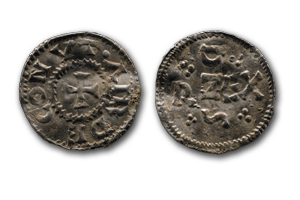
Silver Viking coin
(©The Trustees of the British Museum)
WHAT IS IT?
Coin
DATE
ca. A.D. 900
MATERIAL
Silver
DISCOVERED
Silverdale, Lancashire, northwest England, September 2011
SIZE
Roughly an inch in diameter
Part of a hoard of more than 200 silver artifacts, this coin tells a surprisingly
complete story about kingship at a time when Vikings from Scandinavia
vied with the resident Anglo-Saxons for control of northwest England. The
coin's obverse (front) bears the inscription AIRDECONUT, which scholars
believe is an Anglo-Saxon translation of the Scandinavian name "Harthacnut," a previously
unknown Viking ruler. He is the first new Viking monarch identified since 1840.
The reverse has the letters DNS, an abbreviation of the Latin word dominus ("ruler"), and
REX, Latin for "king." The use of Latin and the words' cross-like arrangement is evidence
that, by only a few decades after the Vikings began settling in Britain in the midninth
century, they had converted to Christianity.
Despite the Viking ruler's adoption of the Anglo-Saxon's religion, the hoard—
a collection of jewelry, ingots (molds for metal casting), and coins, all weighing more than
two pounds and constituting the fourth largest Viking hoard ever found—indicates that
territorial clashes had not ended. The collection, which would have been valuable enough
to buy a herd of cattle or sheep, was likely buried for safekeeping. It was not retrieved until
last year, when a metal detectorist discovered the hoard in a lead container lying slightly
more than one foot underground. He reported the find to local archaeological authorities,
and the artifacts were taken to the British Museum to be cleaned, analyzed, and conserved.

